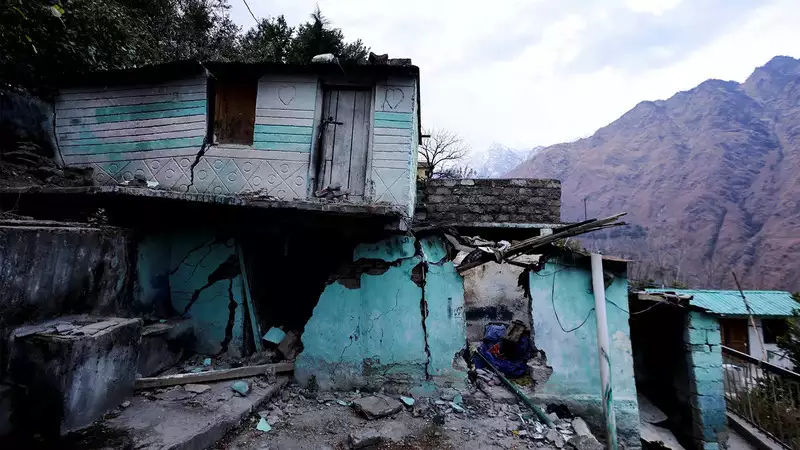This article originally appeared in Times of India
Hills, stop copying the plains: Joshimath shows we need a radically different growth model for Himalayan states

Joshimath is a symptom, the disease is the uncontrolled growth model.
What is unfolding in Joshimath is a tragedy. But this tragedy is not due to climate change; climate change-linked extreme events may have exacerbated the situation, but the sinking of Joshimath is our doing.
The fact is this disaster is not unexpected; it was foretold. Over 50 years, the sinking of Joshimath has been documented by multiple committees of the Supreme Court and the Union and state governments. They warned against haphazard urbanization, large-scale hydropower development and cutting of hills to widen roads. But time and again, their warnings were ignored. The result is that the fate of Joshimath is sealed. Even with engineering solutions, a part of this historic city will have to be abandoned, and the rest will struggle to survive. So, how have we reached this stage, and how do we prevent many more Joshimath’s in the future?
It is important to understand that Joshimath is a symptom; the disease is the strong push in the Himalayan states to replicate the development model of the plains – big infrastructure projects, wider roads, and high-rise buildings. It is this uncontrolled growth model that is seriously compromising their environmental security.
Destructive growth
Let’s look at the hydroelectric projects (HEPs) in Uttarakhand. The state presently has 39 large and small HEPs with an installed capacity of 3600 MW. In addition, there are 25 HEPs worth 2400 MW capacity under construction. So, in a couple of years, Uttarakhand will have 64 HEPs of 6000 MW capacity.
But what is existing and under construction is just a fraction of what is being planned. There are 180 HEPs of 21200 MW capacity in the pipeline. Many have already obtained environmental clearances from the environment ministry and state agencies. Even if we assume that only half of these projects reach fruition, Uttarakhand will have 150 HEPs, and its hydropower capacity will increase four-fold from the present. This is plainly unsustainable.
Scientists have warned against building hydropower without comprehensive studies, and government committees have recommended scrapping HEPs. Yet, many projects with questionable feasibility continue to be constructed. Take the case of the Tapovan Vishnugad HEP, which is blamed for the aquifer breach at Joshimath.
Construction of this 520 MW project began nearly 17 years ago and was scheduled to be completed in 2013. But, almost a decade later, the project is still ‘under construction’, and its price tag has more than doubled. Moreover, this project has been damaged by floods twice — in 2013 and 2021. In 2021 floods caused by an unprecedented avalanche, nearly 200 people died, and many were labourers working at the project site. Tapovan Vishnugad exemplifies the risk of large-scale infrastructure development without proper assessment.
It is well-known that the Himalayas is one of the most unstable mountain ranges and is prone to natural disasters. On top of this, global warming is profoundly impacting the geology and hydrology of the region. Data shows that 90% of earthquakes, most landslides and a large proportion of cloudbursts in India occur there. With massive infrastructure development and more people living in vulnerable areas, the economic and ecological losses are mounting and will continue to grow unless we make fundamental changes in the development paradigm.
Promote the alternate vision of development
The first change is to stop copying the plains. The domain of environmental science tells us that every place has a carrying capacity. Once this capacity is exceeded, ecological destruction ensues. Himalayas have a much lower carrying capacity than plains and thus can sustain much lower human pressure. Therefore, better planning and enforcement are essential to ensure that the carrying capacity is not breached. But unfortunately, the institutions which can ensure this, like the Town and Country Planning (TCP) department and the environment department, are weak and ineffective in hill states. In Uttarakhand, for instance, the TCP department is operating with minimal staff and resources, and the re-organization of the department has not been done since the bifurcation from Uttar Pradesh. Without solid planning and enforcement, the Himalayan states are doomed.
The second is to practice an alternate model of development, an immediate requirement in the tourism sector. It is projected that 250 million tourists will visit these states by 2025; the number was 100 million before the pandemic. This massive growth will exacerbate water scarcity, worsen air quality and lead to forest and land degradation. But there is an alternative to this unsustainable tourism — high-value sustainable tourism. We can follow the example of Bhutan, which has capped the number of travellers by imposing a sustainable development fee of US$200 per day. A part of this fee goes into environmental protection and enhancing livelihood for local residents. A similar sustainable tourism policy is required for our Himalayas too.
Lastly, in this era of climate change, Himalayan states can create a large number of jobs in the environment sector – biodiversity conservation, high-value organic farming, sustainable forestry, glacier and water body protection etc. And they can be incentivized by the rest of the country to do this. This is because they are major water sources that sustain the plains, and their glaciers, forests and biodiversity are essential for the country’s ecological security. While some progress has been made on Payments for ecosystem services, a lot more needs to be done so that these states can develop and prosper without destroying themselves.
Chandra Bhushan is one of India’s foremost public policy experts and the founder-CEO of International Forum for Environment, Sustainability & Technology (iFOREST).
